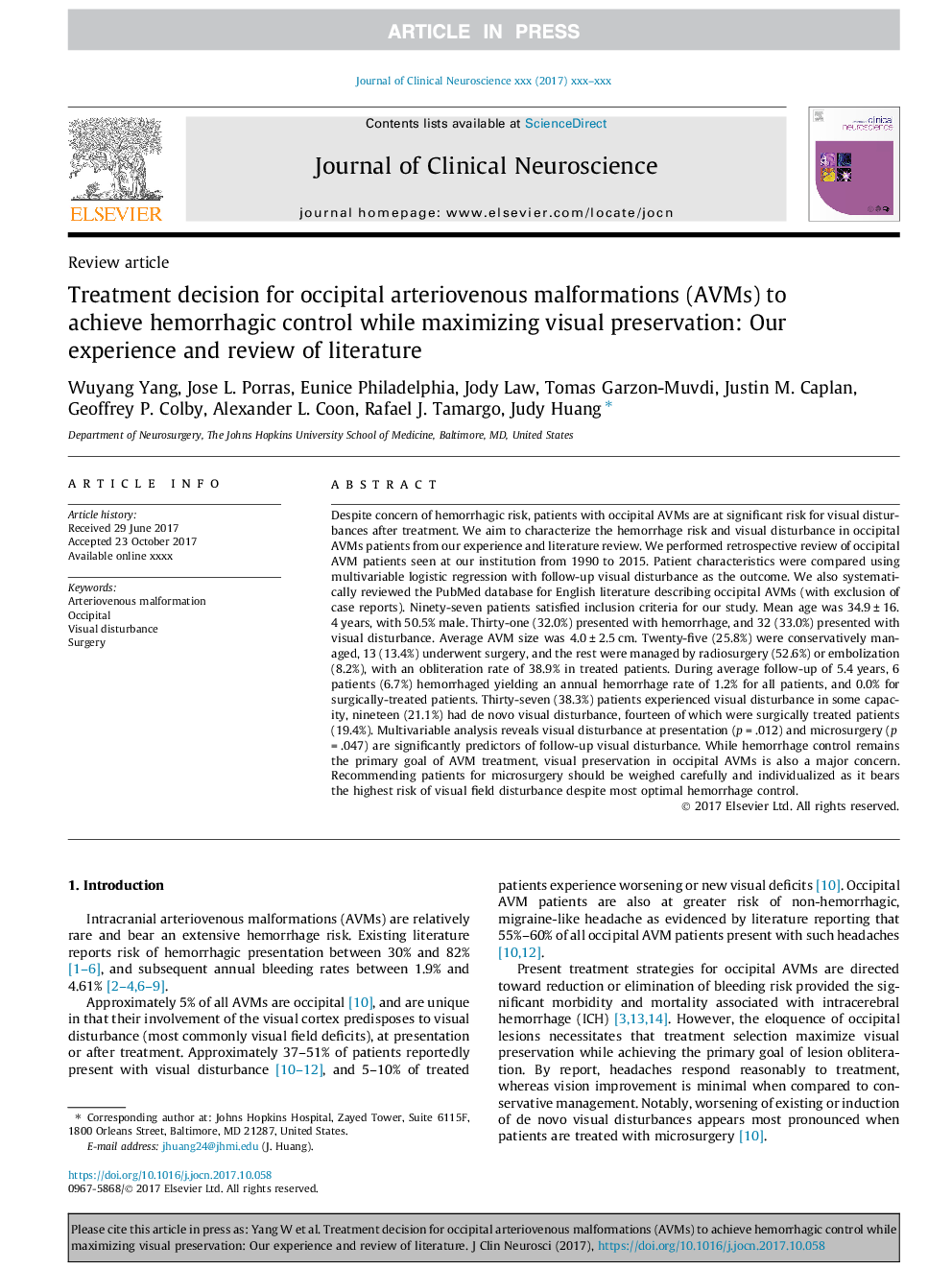| کد مقاله | کد نشریه | سال انتشار | مقاله انگلیسی | نسخه تمام متن |
|---|---|---|---|---|
| 8685267 | 1580268 | 2018 | 8 صفحه PDF | دانلود رایگان |
عنوان انگلیسی مقاله ISI
Treatment decision for occipital arteriovenous malformations (AVMs) to achieve hemorrhagic control while maximizing visual preservation: Our experience and review of literature
دانلود مقاله + سفارش ترجمه
دانلود مقاله ISI انگلیسی
رایگان برای ایرانیان
کلمات کلیدی
موضوعات مرتبط
علوم زیستی و بیوفناوری
علم عصب شناسی
عصب شناسی
پیش نمایش صفحه اول مقاله

چکیده انگلیسی
Despite concern of hemorrhagic risk, patients with occipital AVMs are at significant risk for visual disturbances after treatment. We aim to characterize the hemorrhage risk and visual disturbance in occipital AVMs patients from our experience and literature review. We performed retrospective review of occipital AVM patients seen at our institution from 1990 to 2015. Patient characteristics were compared using multivariable logistic regression with follow-up visual disturbance as the outcome. We also systematically reviewed the PubMed database for English literature describing occipital AVMs (with exclusion of case reports). Ninety-seven patients satisfied inclusion criteria for our study. Mean age was 34.9â¯Â±â¯16.4â¯years, with 50.5% male. Thirty-one (32.0%) presented with hemorrhage, and 32 (33.0%) presented with visual disturbance. Average AVM size was 4.0â¯Â±â¯2.5â¯cm. Twenty-five (25.8%) were conservatively managed, 13 (13.4%) underwent surgery, and the rest were managed by radiosurgery (52.6%) or embolization (8.2%), with an obliteration rate of 38.9% in treated patients. During average follow-up of 5.4â¯years, 6 patients (6.7%) hemorrhaged yielding an annual hemorrhage rate of 1.2% for all patients, and 0.0% for surgically-treated patients. Thirty-seven (38.3%) patients experienced visual disturbance in some capacity, nineteen (21.1%) had de novo visual disturbance, fourteen of which were surgically treated patients (19.4%). Multivariable analysis reveals visual disturbance at presentation (pâ¯=â¯.012) and microsurgery (pâ¯=â¯.047) are significantly predictors of follow-up visual disturbance. While hemorrhage control remains the primary goal of AVM treatment, visual preservation in occipital AVMs is also a major concern. Recommending patients for microsurgery should be weighed carefully and individualized as it bears the highest risk of visual field disturbance despite most optimal hemorrhage control.
ناشر
Database: Elsevier - ScienceDirect (ساینس دایرکت)
Journal: Journal of Clinical Neuroscience - Volume 48, February 2018, Pages 50-57
Journal: Journal of Clinical Neuroscience - Volume 48, February 2018, Pages 50-57
نویسندگان
Wuyang Yang, Jose L. Porras, Eunice Philadelphia, Jody Law, Tomas Garzon-Muvdi, Justin M. Caplan, Geoffrey P. Colby, Alexander L. Coon, Rafael J. Tamargo, Judy Huang,